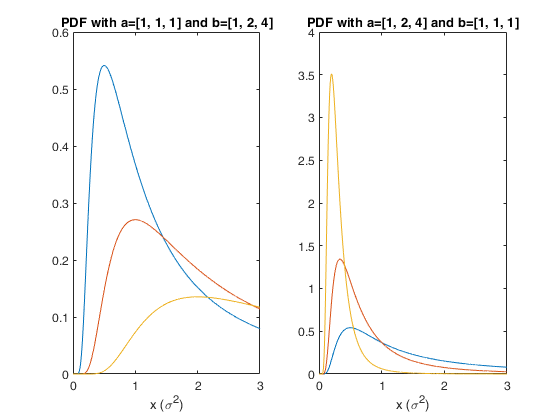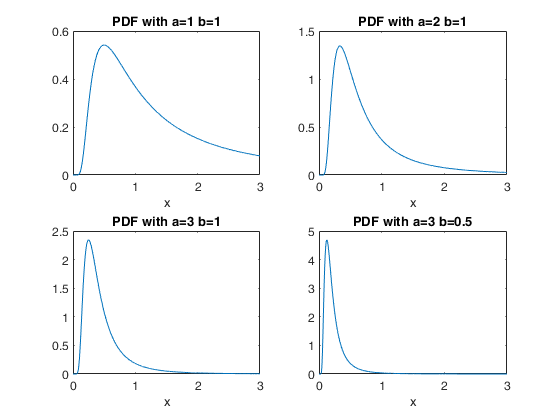inversegampdf
inversegampdf computes inverse-gamma probability density function.
Description
Examples
 Compare the results using option nocheck=1.
Compare the results using option nocheck=1.
 Compare the results using option nocheck=1.
Compare the results using option nocheck=1.
x=(0:0.001:3)';
a=[1,2,3,50,100,10000];
b=[1,10,100,0.05,10,800];
Y=zeros(length(x),length(a));
Ychk=Y;
for i=1:length(x)
Y(i,:) = inversegampdf(x(i),a,b);
Ychk(i,:)= inversegampdf(x(i),a,b,1);
end
disp('Maximum absolute difference is:');
disp(max(max(abs(Y-Ychk))));Maximum absolute difference is:
0.00
Related Examples
 Interpretation in Bayesian statistics.
Interpretation in Bayesian statistics.
 Interpretation in Bayesian statistics.
Interpretation in Bayesian statistics.Interpretation of a inverse Gamma (conjugate) prior, used for estimating the posterior distribution of the unknown variance $\sigma{^2}$ of a normal $N(0,\sigma{^2})$.
% a set of values for $\sigma^2$
x=(0:0.001:3)';
% Two panels with inverse Gamma distribution for different parameters
% settings.
% Left panel: fixed shape (1), increasing scale (1,2,4);
% As the scale parameter increases, the mean of the distribution (more
% and more skewed to the right) also increases. This suggests that an
% inverse Gamma prior with a larger scale parameter incorporates a prior
% belief in favour of a larger value for $\sigma^2$.
a = [1, 1, 1];
b = [1, 2, 4];
subplot(1,2,1);
for j=1:3
plot(x,inversegampdf(x,a(j),b(j)));
hold on;
xlabel('x (\sigma^2)');
end
title('PDF with a=[1, 1, 1] and b=[1, 2, 4]');
% Right panel: fixed scale (1), increasing shape (1,2,4);
% As the shape parameter increases, the distribution becomes more and
% more centered around the mean, producing a tighter set of prior beliefs.
b = [1, 1, 1];
a = [1, 2, 4];
subplot(1,2,2);
for j=1:3
plot(x,inversegampdf(x,a(j),b(j)));
hold on;
xlabel('x (\sigma^2)');
end
title('PDF with a=[1, 2, 4] and b=[1, 1, 1]');
Input Arguments
x — Value at which the pdf must be evaluated.
Scalar, vector or matrix 3D array of the same size of a and
b.
A scalar input functions as a constant matrix of the same size as the other input.
See "More About:" for details about the inverse gamma distribution.
Data Types: single | double
a — shape parameter of the inverse-gamma distribution.
Scalar, vector or matrix 3D array of the same size of x and b.
A scalar input functions as a constant matrix of the same size as the other input.
See "More About:" for details about the inverse gamma distribution.
Data Types: single | double
b — scale parameter b of the inverse-gamma distribution.
Scalar, vector or matrix 3D array of the same size of x and a.
A scalar input functions as a constant matrix of the same size as the other input.
See "More About:" for details about the inverse gamma distribution.
Data Types: single | double
Optional Arguments
nocheck — Check input arguments.
Scalar.
If nocheck is equal to 1 no check is performed and input and the density is evaluated directly through the expression y = (b.^a).*(x.^(-a-1)).*exp(-b./x)./gamma(a) else we use MATLAB function gampdf.
Example: 'nocheck',1
Data Types: double
Output Arguments
y —Inverse-gamma pdf value.
Scalar, vector or
Scalar, vector or $y=f_{IG}(x | a,b)$ is the value of the pdf of the inverse gamma distribution evaluated at x.
More About
Additional Details
The density of the inverse gamma distribution defined over the support $x>0$ with shape parameter $a$ and scale parameter $b$ is \[ f_{IG}(x, a, b) \propto x^{-a -1} \exp (-b/x) \frac{b^a}{\Gamma(a)} \]
inversegampdf computes the gamma pdf at each of the values in x using the corresponding shape parameters in a and scale parameters in b. Parameters x, a, and b can be vectors, matrices, or multidimensional arrays that all have the same size. A scalar input is expanded to a constant array with the same dimensions as the other inputs. The parameters in a and b must all be positive and the values in x must be in the interval $[0,\infty)$.
The chief use of the inverse gamma distribution is in Bayesian statistics, where the distribution arises as the marginal posterior distribution for the unknown variance of a normal distribution if an uninformative prior is used; and as an analytically tractable conjugate prior if an informative prior is required. See the last example below.
Relation with the Gamma distribution.
If $X \sim Gamma(a,b)$ then $\frac{1}{X} \sim$ inverse-gamma distribution with paramters $a$ and $1/b$.
See the appendix of Zellner (1971) for a detailed description of the inverse Gamma distribution.
References
Zellner, A. (1971), "An introduction to Bayesian Inference in Econometrics", Wiley.
[ https://en.wikipedia.org/wiki/Inverse-gamma_distribution ]
